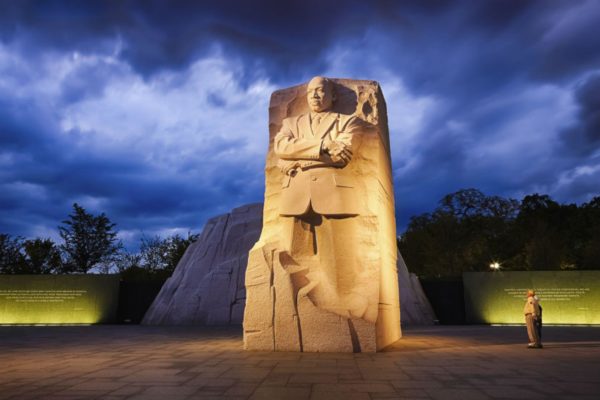The assassination of Martin Luther King Jr. in April 1968 was a pivotal moment in the manifestation of racial politics in America. The traumatic occurrence also had a marked influence on the arts in the U.S.
In the wake of King’s murder, a significant number of traditionally conservative arts institutions immediately altered their programs to accommodate a variety of tributes. Perhaps one of the most significant was New York’s Museum of Modern Art’s rapidly organized exhibition, “In Honor of Dr. Martin Luther King.”
Taking place just seven months after King’s murder, the exhibition consisted of works by many leading artists of the time, the sales of which benefitted the Southern Christian Leadership Conference, an African-American civil rights organization for which King served as its first president. Participating artists included the likes of Romare Bearden and Jacob Lawrence, but also white artists such as Robert Rauschenberg and Mark Rothko.
There were also a number of poignant responses in the arts to King’s murder. Not surprisingly, African-American artists were in the forefront of such responses, and one of the most passionate and pleading manifestations of this was Nina Simone’s “Why? (The King of Love Is Dead),” recorded and released as a single soon after King’s murder. Certain singers and musicians had never shied away from social comment in their songs and music, but King’s murder marked a particular moment of articulation of protest in the arts.
In responding to King’s assassination, white-controlled arts institutions, from theaters to art galleries to museums, realized that their programs had to attempt to recognize the importance of diversity. Of course, the range of African-American led arts organizations across the country reacted to King’s murder with similar initiatives, pointing to the urgent need for a shared, cathartic response.
While some may be exasperated by the inconsistency with which major arts organizations responded to the challenges of enacting diversity, when we see African-American art(s) in the institutions around us, we can often trace such programming back to a 1968 moment.
Today, given the challenging nature of these times, there is perhaps a certain nostalgia for the exigent messages articulated in the arts of the 1960s, most notably after King’s assassination. Several galleries recently hosted “Witness: Art and Civil Rights in the Sixties.”
Taking its cue from the passing of the Civil Rights Act 50 years earlier, “Witness” struck a chord with gallery-going audiences. The 1960s are, after all, remembered as a time of dramatic social, political and cultural upheaval across the country. Equally as important, the ’60s are recalled as a time in which many of the nation’s artists responded to the urgency of the times by making some of the most principled and engaging work of the modern and contemporary era.
It is, arguably, the duty of arts organizations to respond to seismic moments in our nation’s history, and it was King’s untimely passing 50 years ago that gave, within the arts, a pronounced fillip to manifestations of cultural diversity and the struggle for racial equality.
Eddie Chambers is a professor of art and art history at The University of Texas at Austin.
A version of this op-ed appeared on CNN Digital.
To view more op-eds from Texas Perspectives, click here.
Like us on Facebook.




